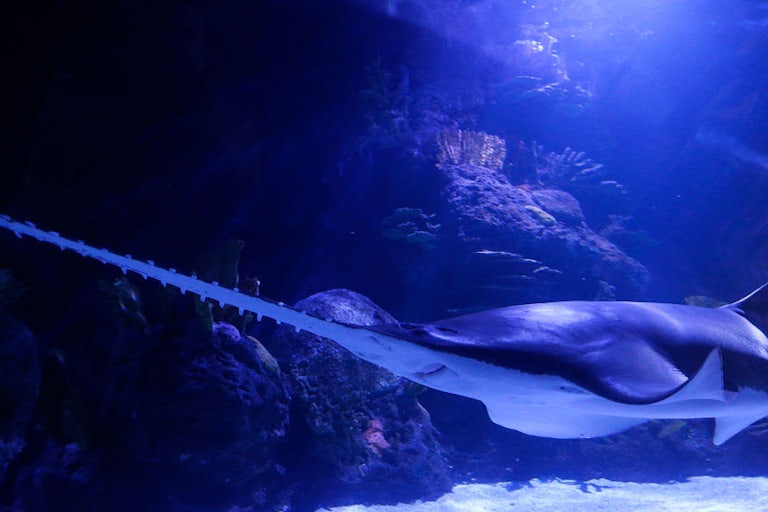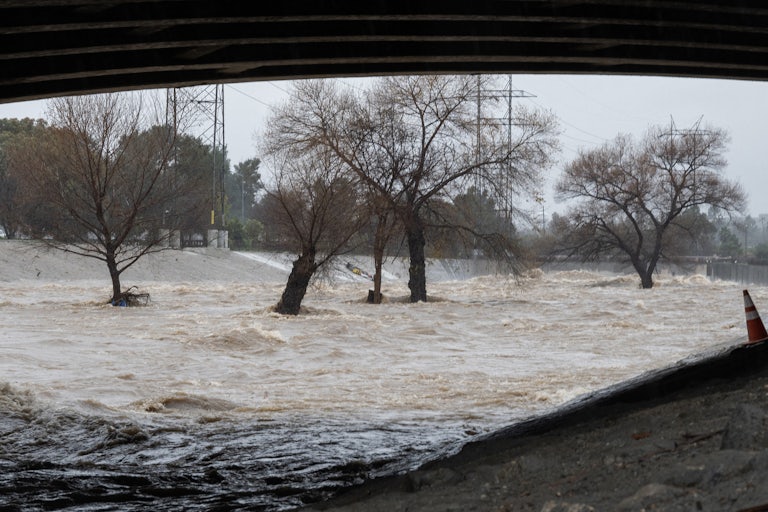Fish Are Behaving Erratically and Dying. No One Knows Why.
Endangered smalltooth sawfish are one of many species that have been seen spinning around and beaching themselves off the Florida Keys.

Something strange is happening in the waters off the Florida Keys. For months now, thousand-pound fish with three-foot serrated beaks have been spinning around in seeming distress, beaching themselves, and dying. The news largely escaped national attention until the National Oceanic and Atmospheric Administration announced last week that it would be coordinating an “emergency response effort” to rescue these fish, prompting a string of pieces in major outlets.
It’s not a story that gets less disturbing or strange the more you learn about it. Quite the opposite.
NOAA is mobilizing because the fish in question, the smalltooth sawfish, is an endangered species—one of only five sawfish species in the world, all of which are threatened. “It’s a big ray with a big crazy hedge trimmer on the edge of its head,” says Florida State University marine biologist Dean Grubbs, who’s been on NOAA’s Smalltooth Sawfish Recovery and Implementation Team since 2009. The fish, “which are close to bull sharks in terms of where they are on the food chain,” Grubbs added, have been hit hard by commercial fishing bycatch, trophy hunting, and habitat loss—particularly of the mangroves where young sawfish hide from predators while they grow. They’ve been protected in Florida since 1992 and listed under the Endangered Species Act since 2003. “We were sort of celebrating the twentieth anniversary of the listing,” Grubbs said, because “we were actually seeing some positive signs of recovery”—until this happened.
But sawfish aren’t the only ones behaving strangely. “There have been I think over 40 species of fishes that have been seen doing this weird spinning behavior,” Grubbs said, and it started months ago, as early as November of last year. People simply started noticing it more when they saw the sawfish with their giant rostrums—that’s the big serrated beak-like apparatus—in the shallow water starting in January. “Most residents of the Florida Keys have never seen a sawfish, and that’s why it caught everybody’s eye.”
Fish losing their minds en masse is alarming, although it seems confined to the Keys. “The theory is that it’s something that seems neurotoxicological,” Grubbs said, but the routine water testing isn’t showing anything suspicious. The head of Mote Marine Laboratory, involved in the response, told CBS News, “This seems to be some kind of an agent that is in the water that is negatively impacting just the fish species.”
While many fish may die while awaiting an answer, the sawtooth population is particularly vulnerable. Given that genetic analysis of the smalltooth sawfish population estimates that there could be only around 400 breeding females left, Grubbs said, this sort of unexplained phenomenon is pretty worrisome. Nearly 30 adult sawfish have been confirmed dead, with possibly many more whose carcasses simply haven’t been found, and over 100 live sawfish have been observed exhibiting this odd spinning behavior. That’s a sizable portion of the total population, which doesn’t have a great capacity to bounce back. Researchers think it may take sawfish a decade or more to reach sexual maturity.
The plan to buy the sawtooths time while researchers figure out what’s going on is pretty wild: to capture live sawtooths, take them out of the ocean (so they can’t beach themselves or get any sicker if the problem is being caused by the water), and quarantine them until they recover and researchers have answers. This is not a minor task when talking about an animal 10 to 15 feet long that weighs about as much as a horse and needs to remain submerged. NOAA’s statement last Wednesday listed Ripley’s Aquariums, the research nonprofit Mote Marine Laboratory, and aquarium and pet store supplier Dynasty Marine Associates as three locations where sawfish might be taken for quarantine. To make this work, NOAA also has to find “transport routes,” Grubbs noted. Meanwhile, the testing will continue—of water, of samples from dead sawtooths and other fish, and of samples from healthy fish, which Grubbs and his team helped provide from a recent research trip.
These sorts of mass mortality events, as Marion Renault wrote for TNR last year, are becoming more common. “We’re nowhere close to grasping the repercussions these cascades of death have on ecosystems,” Marion wrote. “One catastrophe makes it more likely that you’ll suffer a second or third,” one zoologist told her. “And every devastation,” Marion wrote, “leaves an ecosystem more vulnerable for the next.”
The mystery of the spinning fish is strange enough, hopefully, to seize the nation’s attention. But it’s just one part of a larger onslaught on Florida’s coastal ecosystems, degraded by runoff and sewage, toxic algal blooms, and soaring temperatures that reduce the amount of oxygen in the water. Those studying sawfish may be particularly anxious, unsure whether the population can rebound. But, said Grubbs, “I think it’s a big environmental concern for all of us.”
Good News/Bad News
![]()
There are a growing number of alternatives to plastic when it comes to food packaging, The New York Times reports. But current systems for distributing food, and patterns people have when it comes to buying and consuming food, aren’t going to make eliminating plastic easy.
![]()
Landfills are emitting way more methane than previously thought.
Stat of the Week
140%
That’s the increase in incidence of dengue fever in Puerto Rico so far this year compared to this time last year. Read Zoya Teirstein’s report at Grist about the disease’s alarming spread.
What I’m Reading
HOAs are blocking solar panels and native lawns. Here’s how to fight back.
This column from The Washington Post’s “climate coach” tells the story of two people—a software engineer near D.C. and a climate journalist in Lockhart, Texas—who have defied homeowners associations to transform their front lawns into a vegetable garden and a miniature prairie landscape, respectively. It also contains advice for those who want to follow in their footsteps.
Power is shifting back into the hands of property owners after state legislators have begun rolling back decades of escalating HOA restrictions. But many members of HOA boards don’t know these provisions, or ignore them.
“Unfortunately, it sounds cliché, but there are association board members who are on a power trip,” says Luke Carlson, an attorney and founder of LS Carlson Law specializing in HOA disputes. “They will not listen to reason until you notify someone in their camp that what is happening is wrong, and it’s violating the owners’ rights and well-established law. But it takes a little bit of fight to get some traction.”
Read Michael J. Coren’s column at The Washington Post.
This article first appeared in Life in a Warming World, a weekly TNR newsletter authored by deputy editor Heather Souvaine Horn. Sign up here.









